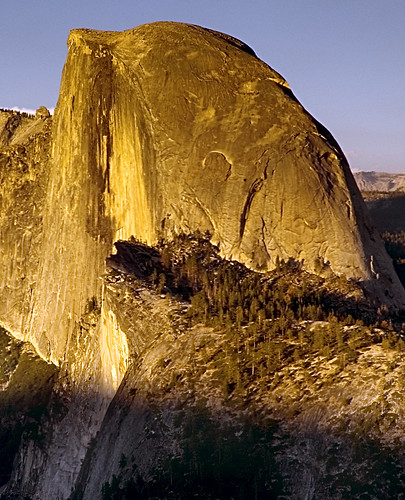 Yosemite Valley at Night, photo by Harold Davis. View this image larger.
Yosemite Valley at Night, photo by Harold Davis. View this image larger.Photographing at night can be literally a trip into the unknown, dark and impenetrable. Often you can see neither your photographic subject nor your camera controls. You may be flailing around in the murk and gloom, at some risk of tripping over obstacles or falling down unseen cliffs. It’s hard to have an accurate idea of how vistas will render on digital. Light pollution from unexpected sources–a car passing, or a security guard shining a light at you to see what you are doing–is always possible. Almost certainly, it will be much colder than during the daytime.
So why bother?
One answer is because of the challenge. It’s technically demanding, so successfully photographing the night feels rewarding.
Night, and darkness, are there. Something like half our time is spent off the diurnal clock. Absent the luxuries of cilization, this nocturnal world is our world, and yet it is largely unseen. Making the unseen visible is one of the highest uses of photography.
So photography of landscapes in extremely low light shows us things we’d never see otherwise. And this revelation is often surprisingly interesting or beautiful (a case in point, these unexpected landscapes taken well after sunset).
If you decide to try night photography, dress warmly. Carry several light sources, preferably including a headlamp. You’ll need to know your equipment, including your tripod, well enough to work it essentially by feel.
Night exposures are almost by definition manual exposures, so you should expect to make trial exposures and adjust accordingly. As I’ve explained before, you’ll need a programmable remote device to make exposures longer than the maximum shutter speed setting on your camera (often thirty seconds).
Yosemite Valley at Night (above) is a 180 second exposure with the lens wide open taken from the road near Curry Village. It was part of the same series of exposures as Night in Yosemite, but instead of facing Glacier Point the photo shows the view past Mirror Lake and up Tenaya Canyon.
I literally couldn’t see what I’d pointed the camera at as I exposed the image (partly because the car headlights shown in the lower right blinded me). During the exposure, some people with a bright lantern walked slowly past, glancing at me with curiousity as I desperately tried to shield the lens from their light.
In the photo, clouds obscure Half Dome (shown on the right side above and in daylight below).

Pingback: Photoblog 2.0: » Photoblog 2.0 Archive: » Gerbode Valley
Pingback: Photoblog 2.0: » Photoblog 2.0 Archive: » Golden Gate at Night
Pingback: Photoblog 2.0: » Photoblog 2.0 Archive: » Mount Tamalpais at Night
Pingback: Photoblog 2.0: » Photoblog 2.0 Archive: » Tennessee Valley at Night
Pingback: Photoblog 2.0: » Photoblog 2.0 Archive: » Star Light Star Bright
Pingback: Photoblog 2.0: » Photoblog 2.0 Archive: » Improv on Mission Peak
Pingback: Photoblog 2.0: » Photoblog 2.0 Archive: » Night Shore
Pingback: Photoblog 2.0: » Photoblog 2.0 Archive: » Creature of the Night (or, the were-Photographer)
Pingback: Photoblog 2.0: » Photoblog 2.0 Archive: » Midnight Rambles